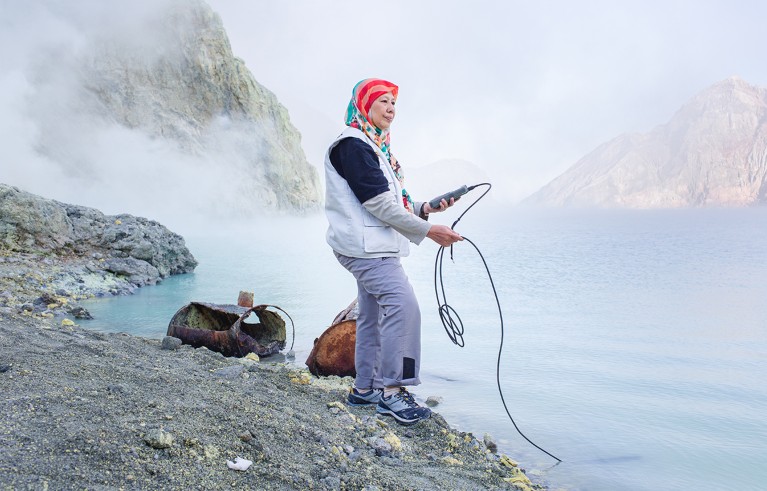Hello Nature readers, would you like to get this Briefing in your inbox free every day? Sign up here.

Dust storms turned skies yellow on 27 March 2024 in Erenhot, Inner Mongolia.Credit: VCG via Getty
AI could help predict lethal dust storms
Many Asian countries are facing an annual problem: dust storms linked to increased deaths from cardiovascular and respiratory conditions. These storms — like the ones that battered Beijing over the weekend — occur when strong winds sweep across dry areas, such as deserts, picking up dust particles from the ground and lifting them into the air, sometimes to as high as 1,500 metres. Researchers in the region have been applying artificial intelligence and climate modelling to better predict the timing, location and severity of the annual phenomenon.
Octopuses struggle with rising temperatures
Heat stress caused by global warming could mean some octopuses will struggle to survive. Scientists exposed Octopus berrima and their embryos to three different temperatures: a control of 19 ℃, current summer water temperature of 22 ℃, and 25 ℃ — a possible ocean temperature in 2100. Octopus embryos exposed to 25 ℃ expressed significantly lower levels of key eye proteins, and had a higher rate of mortality. Loss of vision would greatly affect octopuses as they rely on sight for survival: about 70% of the octopus brain is dedicated to vision. Octopuses are thought to be highly adaptable, but this new work suggests they could suffer with warming of only three degrees.
Reference: Global Change Biology paper
Dinosaurs break body size trend
Dinosaurs buck Bergmann’s rule, a more than 170-year-old biological principle suggesting that species from colder environments are generally larger than close relatives from warmer climates. An analysis of more than 300 dinosaur species showed no correlation between size and latitude. Bergmann’s rule is generally applied to mammals and birds, but the researchers discovered that birds’ body sizes show only a modest temperature trend — and that it’s absent in mammals. “This suggests that Bergmann’s ‘rule’ is really the exception rather than the rule,” says palaeontologist and study co-author Lauren Wilson.
Reference: Nature Communications paper
Features & opinion
A memoir of botany and motherhood
As a botanist, Erin Zimmerman was unafraid to travel, climb trees, face snakes or rodents. But she worried about what having children would do to her career, and her fears were well-founded: in the United States, 43% of women with full-time jobs in science leave the sector or take on part-time roles after having their first child (compared to 23% of new fathers). Overworked, in pain, accused of having ‘brain fog’, dismissed for her concerns about working in a pesticide-sprayed greenhouse while pregnant and, later, longing for her infant daughter, Zimmerman eventually switched to science journalism. In her new book Unrooted, Zimmerman finds parallels between the obstacles faced by women in science and global threats to plants.
The secret social lives of viruses
Researchers are uncovering the complex social lives of viruses, including behaviours that resemble cheating, cooperation and interaction. ‘Sociovirologists’ are moving away from viewing viruses as isolated particles to studying how they engage as members of a group. “We think of them as part of a community,” says virologist Carolina López, “with everybody playing a critical role.” Some of these insights could lead to new therapies against viral diseases.
Can ‘genetic rescue’ save vulnerable species?
In Australia, scientists are using techniques, ranging from crossbreeding to gene editing, to alter the genomes of endangered native wildlife, hoping to give them traits they need to survive. Some interventions aim to rescue inbred populations before they disappear forever. But the work challenges traditional ideas of species purity, and carries risks of destabilising ecosystems in unpredictable ways. “We’re searching for solutions in an altered world,” argues ecologist Dan Harley. “We need to take risks. We need to be bolder.”
The New York Times | 11 min read
Why some people always get lost
Upbringing and life experience matter more than genetics when it comes to being a good navigator. For example, people who live in cities with chaotic street layouts tend to have better wayfinding skills than those from places with grid-like streets. In places where women face cultural restrictions on exploring their environment, researchers found a navigation gender gap. The ability to build and refer to a mental map seems essential for good navigation, more so than being able to follow a route using landmarks. “To get good at navigating, you have to be willing to explore,” says cognitive scientist David Uttal.
Knowable Magazine | 10 min read
Reference: Topics in Cognitive Science paper & Current Directions in Psychological Science paper
Where I work

Hanik Humaida is an analytical chemist at the Centre for Volcanology and Geological Hazard Mitigation in Yogyakarta, Indonesia.Credit: Gaia Squarci for Nature
Analytical chemist Hanik Humaida takes measurements of the world’s largest acid lake, which sits in the crater of Indonesia’s Ijen volcano. “Its 36 million cubic metres of acidic water could be very dangerous to the surrounding population if there is an eruption,” she explains. Analysing the lake’s chemistry helps to monitor the volcano’s activity. “When the activity changes, so does the chemical composition of the water — as well as its colour, which ranges from white to turquoise blue.” (Nature | 3 min read)
